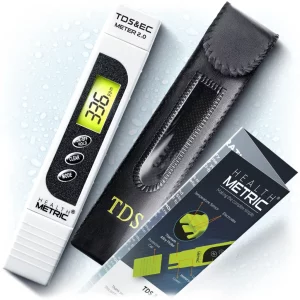
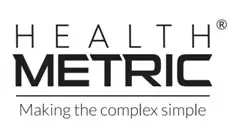 TDS & EC METER 2.0
TDS & EC METER 2.0
User Guide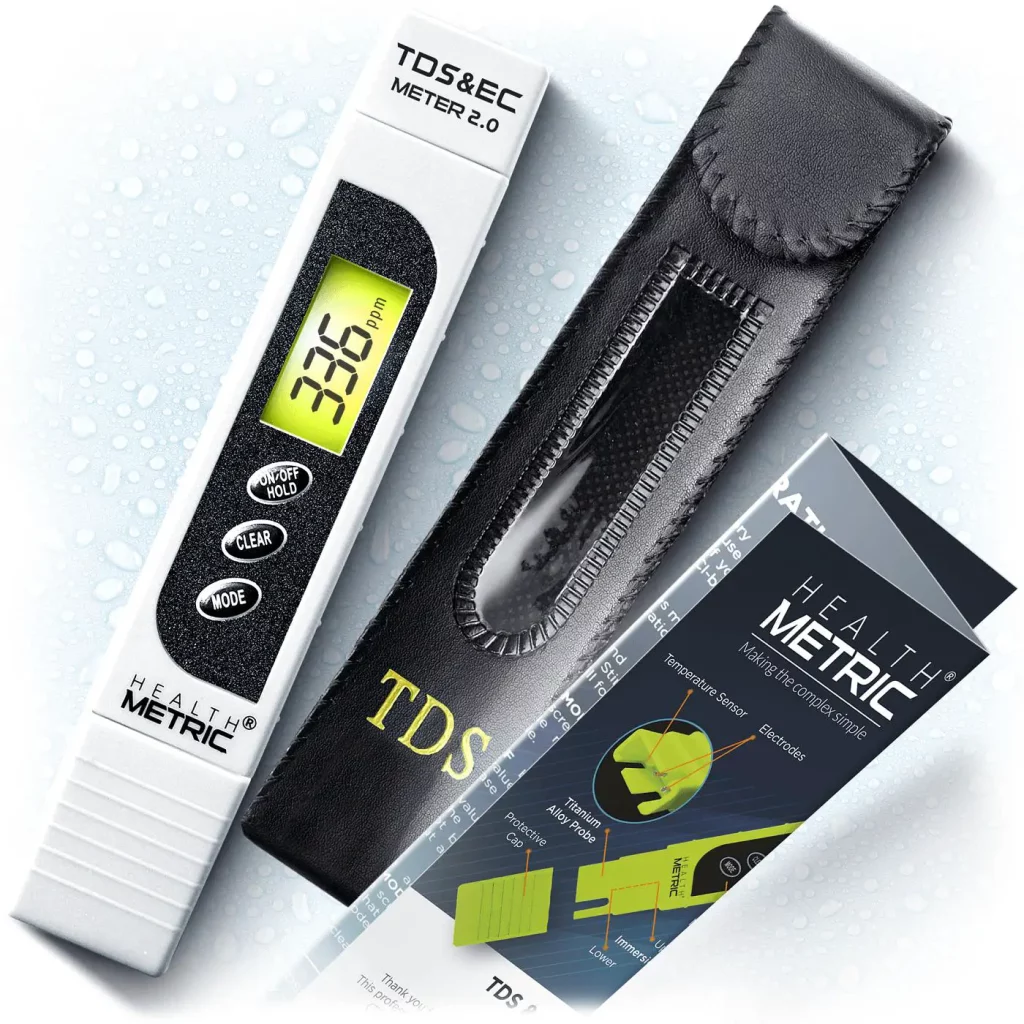
Thank you for choosing the Health Metric 3-in-1 TDS & EC Meter 2.0. This professional measuring device makes testing for total dissolved solids (TDS), electrical conductivity (EC), and temperature super easy.
The following guide gives you a brief overview of what is TDS, how TDS meters work, where can they be used, and how to take care of your TDS meter. For more information and helpful video instructions, visit www.health-metric.com/tds2.
Should you have any questions, feel free to get in touch. We are here to help! [email protected]

What is TDS?
TDS stands for Total Dissolved Solids. It is the measurement of all the dissolved substances in a water sample. These “dissolved solids” are mostly inorganic salts like sodium, calcium, magnesium, and potassium cations along with chloride, bicarbonate, carbonate, phosphate, sulfate, and nitrate anions. TDS also includes dissolved organic compounds. Truly accurate TDS measurements must be performed in an analytical laboratory. The water sample is weighed and then heated under tightly controlled conditions to evaporate the water. The remaining weight of the leftover “solids” is used to calculate the TDS in the water sample. The unit of measurement is parts per million (ppm), which is the same as milligrams per liter (mg/l). However, this level of accuracy is not necessary for most at-home testing applications. It is expensive and must be performed in a qualified laboratory. Using a TDS meter is a much faster method.
How TDS meters work
TDS meters do not directly measure the total dissolved solids. Remember, the TDS is determined by evaporating the water and weighing the remaining solids. Hand-held TDS meters measure electrical conductivity (EC). The EC unit of measurement is a microsiemens (µS). Dissolved inorganic substances like salts, minerals, nitrate, phosphate, and metals conduct electricity. The higher the concentration of these substances in the water sample, the higher the electrical conductivity. The TDS meter converts the EC reading into TDS as parts per million (ppm). Dissolved organic compounds do not conduct electricity and are therefore not detected by TDS meters. TDS meters cannot be used to test for organic substances like pesticides, gasoline, and solvents.
Why is the TDS important?
TDS is not a measurement of harmful substances or pollutants. TDS is simply a measurement of all substances dissolved in water. Distilled water has a TDS of 0.0 ppm, while the ocean has a TDS of 10,000 ppm. Both water sources are safe. An acceptable TDS is relative to the water being tested and what the water is used for. Here is an example: If you tested the TDS of distilled water and found it to be 300 ppm, you would know that the water was not distilled. Perhaps the water purification system was faulty, or something had contaminated the distilled water. TDS testing is like a watchdog. It will tell you if things are not as they should be. Let’s take a look at all the ways you can use a TDS meter to check water quality.
TDS and tap water
Tap water contains a variety of minerals and salts like calcium, magnesium, chloride, and potassium. The more minerals and salts in the water, the higher the TDS. The United States Environmental Protection Agency sets the standards for drinking water in the US. For aesthetics, the recommended maximum TDS in drinking water is 500 ppm. A high TDS usually indicates that the water source contains a high level of minerals, carbonates, and other salts. This water is probably corrosive to plumbing fixtures, pipes, and appliances. The water may taste bad too, due to the high mineral content. However, a high TDS does not necessarily mean that the water is a health hazard.
What TDS level is normal?
“Normal” TDS levels are relative to the type of water being tested. Reverse osmosis water should have a low TDS, and mineral spring water normally has a higher TDS level. We’ve created the following TDS reference chart to help explain this concept.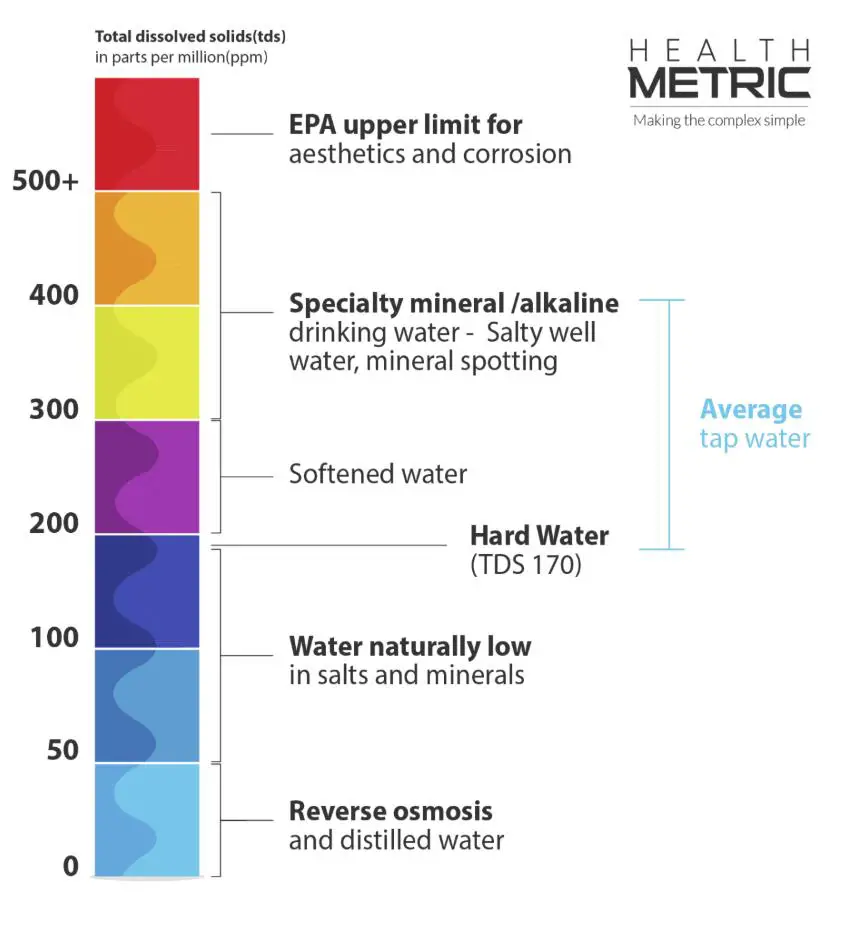
TDS and water filters
Most water filtration systems have no effect on TDS. That’s because they remove organic compounds and chlorine disinfectants that cause taste and odor problems but aren’t detected by TDS meters. While heavy metals are a health concern and contribute to the TDS, their levels are so low that they hardly impact the TDS level. Water softeners use the ion-exchange process. The resin beads in the water softener exchange sodium ions for calcium and magnesium ions (considered as water hardness). Calcium and magnesium minerals are removed but sodium is released in their place. In this case, the EC has not changed, so TDS meters show little if any reduction in TDS. The softened water still has a high TDS level; therefore, a TDS is meter is not suitable for testing water hardness. The best way to monitor water hardness is to use Health Metric Water Hardness Test Strips.
Reverse osmosis (RO) filtration does reduce TDS because it physically removes salts, minerals, and other current-conducting ions from the water. The TDS of RO water should be much lower than the untreated water feeding the RO system. A properly functioning RO system will remove from 70% to 99.9% of the TDS. When an RO system starts removing less than 70% of the incoming TDS, it is time to replace the reverse osmosis membrane and have the system serviced.
Example Calculation
- Incoming water: 300 ppm TDS
- RO water: 30 ppm TDS
- 90% of the TDS is being removed = OK
If RO water = 120 ppm TDS, only 60% of the TDS is being removed. The system needs service.
How to test the TDS of tap water
Turn on the cold water and let it run for about one minute. Take a water sample in a clean plastic or glass container. Place the TDS meter up to the immersion level in the sample and wait for the reading to stabilize. By gently swirling, the meter will help prevent water bubbles from collecting near the two metal probes. TDS meters automatically lock and hold the stabilized TDS level. Rinse in clean water and shake off excess water. Refer to the user manual for more detailed instructions.
How to test bottled water
“Bottled water” is a generic term with no definition other than it is water that is fit for human consumption. Spring water, distilled water, filtered water, and purified water are all different types of drinking water products. Testing the TDS of bottled water is similar to testing tap water. Distilled water will have a TDS of 0. Spring water, purified water, and filtered water, on the other hand, can contain a high level of minerals and salts, which affect the TDS. It is not unusual for bottled water to have a TDS of 100 ppm or higher.
TDS and aquariums
Freshwater tropical fish are native to a variety of aquatic biotopes. South American river fish and plants thrive in water containing almost no minerals, thereby having a low TDS. African lake fish live in high TDS water containing lots of calcium, sodium, and chloride. If you have fish, it is best to keep them in a solution of water with a TDS similar to their natural habitat. A high TDS can wreak havoc by causing cloudy water that sunlight cannot penetrate, therefore harming the process of photosynthesis for aquatic plant life. It can also affect the growth of the fish, impact their breathing, and make them more prone to disease. So, the TDS measurement can be used to decide the frequency of changing the water in a tank.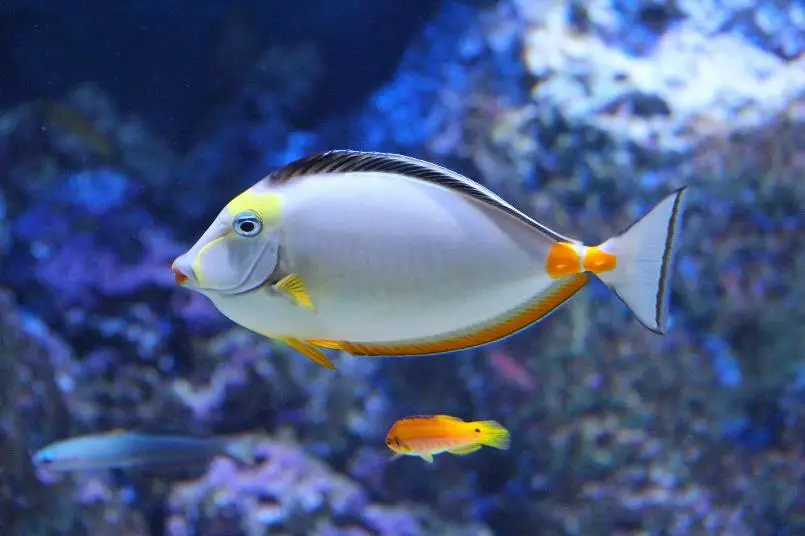
Examples of an ideal TDS range for aquarium fish and ornamental pond fish
- 350-400 ppm African lake cichlids
- 200-500 ppm Goldfish, Japanese koi
- 100-300 ppm Guppies, Swordtails, Mollies, Barbs
- 10-100 ppm Angelfish, Discus, Neon tetras
Testing TDS in aquarium water
Simply place the meter into the aquarium, preferably near flowing water. Hold the TDS meter until the reading stabilizes or locks in. Thoroughly rinse the meter after each use. Aquarium water contains salts, algae, and other microbes that must be rinsed from the probe after each use. The TDS of saltwater is around 10,000 ppm and cannot be measured by Health Metric TDS meters.
TDS in pools and spas
The ideal TDS level in pools and spas is an area of debate. Most experts agree that the maximum TDS of a freshwater pool or spa should be no higher than 1,500 ppm. But, as water evaporates and as pool chemicals are added, the TDS can climb closer to 3,000 ppm. Saltwater pools that use a salt generator normally have a TDS level of 3,500 ppm up to 5,000 ppm. The TDS measurement is helpful for detecting a trend of increasing TDS, which indicates a build-up of minerals or pollutants in the water. Simply place the TDS meter in the water and take the measurement. Rinse the meter with freshwater after use.
Note: A TDS meter is not suitable for testing water hardness. The best way to monitor water hardness is to use Health Metric Water Hardness Test Strips.
Measuring pool salt levels
TDS meters can be used for estimating salt levels by using a conversion factor. Multiply the TDS level by 0.9 to obtain a ppm salt level. This is a rough approximation of the actual NaCl level. Pool salt meters are actually TDS meters that automatically perform this calculation. Note that some manufacturers use a different conversion factor to calculate the salt level. You may find that another meter or pool store will provide a different salt level due to this factor.
TDS and electrical conductivity in hydroponics
Electrical conductivity (EC) is a measurement of the strength of the nutrient solution. The higher the conductivity, the more dissolved solids there are in the solution. Delicate plants, cuttings, and seedlings can experience fertilizer burn if the conductivity is too high. Once the plants begin growing, they need a stronger nutrient solution, so conductivity must be increased by adding concentrated nutrient. Some plants prefer a milder nutrient strength, while others grow better and produce better quality fruit with a higher concentration.

Low conductivity implies a low nutrient concentration, which usually results in nutritional deficiencies and slow growth rates of your plants. Basically, a higher conductivity indicates that there is more food for your plants. However, be careful of very high levels as this can burn or kill the plant.
If you have plant nutrient recommendations in EC units, the EC mode is convenient (see more information about the working modes in the product manual). If your plant nutrient recommendations are in ppm values, the TDS mode is easier to use.
Caring for your Health Metric TDS meter
- Your Health Metric TDS meter should not be submerged underwater. Only the probe section should be immersed in water.
- The TDS meter has two metal probes and a tiny plug on the bottom of the meter. Do not scrub or bend the probes.
- Never dip the meter into substances that can coat and damage the probes. Paint, glue, food, and other sticky substances can damage the probes.
- Never dip the TDS meter into boiling liquids.
- When you are finished using your TDS meter, rinse the probe with water, preferably distilled water. The goal is to flush away any contaminants on the probes.
When to calibrate your meter?
- After prolonged usage, recalibration may help to increase the meter’s accuracy.
- TDS meters are more accurate when calibrated at levels that are close to the sample being tested. So, if you’re measuring samples that are around 1000 ppm, for example, we recommend that you calibrate the meter for that specific value.
Get in touch
Visit http://www.health-metric.com/tds2 for further information, FAQs and video instructions. Our water and air quality experts are available to provide support for all Health Metric products and answer your questions. If you need any assistance, contact us at [email protected] for help.